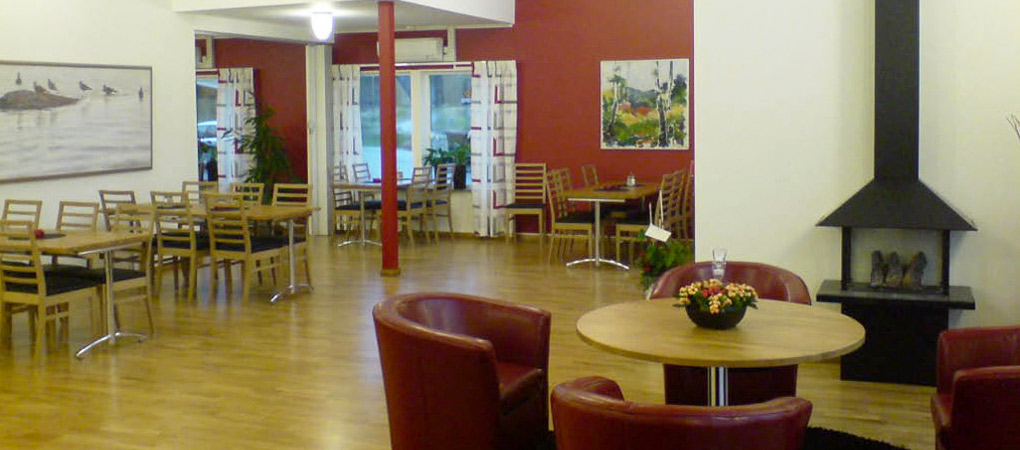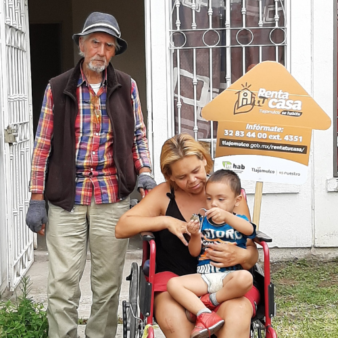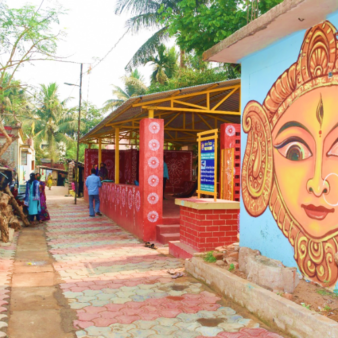Mirum AB is a private limited liability company, registered in 2008 for the purpose of designing and constructing housing for elderly people (and associated activities). The SeniorForum concept for modern living for elderly people was developed as a result of national and European research programmes. The concept involves the provision of affordable accommodation and care for elderly people within a cooperative housing association that all elderly persons in a town are entitled to join. It provides both a residential complex for those who need it and a range of services and social facilities for those who wish to continue living in their own homes. The SeniorForum concept is currently being implemented by Mirum in five different municipalities in the south of Sweden.
Project Description
Aims and Objectives
The objective of the project is to develop a brand new model for elderly people’s accommodation that can resolve the housing and social integration problems faced by the increasing number of elderly persons in Sweden and other countries, providing improved well-being, greater safety and better services at a reasonable cost.
Context
Studies in Sweden have shown that 50 per cent to 70 per cent of people over 65 years old want to stay in their present housing and in their familiar housing environment as long as possible. However, the existing housing is often badly suited to their needs, particularly in respect of accessibility, when stairs limit the resident’s mobility. The lack of daily contact and social fellowship creates isolation and loneliness and reduces the ability to interact with other citizens. The percentage of people aged over 65 in the EU will increase from its current level of 22 per cent to over 40 per cent by 2050 and the percentage over 80 will increase from four per cent to 11 per cent.
The private market has reduced the supply of new-build apartments, as the market price forces up prices and reduces availability. There is a tremendous need for apartments which are physically, socially and economically accessible to elderly people in their own local environment, and which can be a meeting place even for those who may choose to live in their own home but who want to increase their social interaction.
Key features
The SeniorForum concept provides affordable accommodation and care for elderly people within a cooperative housing structure on a town- or village-wide basis. All elderly people in the community can belong to the cooperative association and thus be entitled to all the benefits of the care provided, without necessarily living in the residential complex. Three main models have been developed – these are Bonus (for larger communities with cooperative associations of up to 200 members), Habitat (for small communities with cooperative associations of between 50 and 100 members) and Focus which provides for those who need full-time nursing care.
The designs for the residential complexes are all based on the SeniorForum award-winning design created at Nacka, to the south of Stockholm. The European-wide WelHops project recognised this housing complex as the best of 47 elderly people’s accommodation schemes surveyed in Europe. It is innovative in concept with buildings of different heights around a large garden area. The internal layout makes maximum use of natural light and enables easy access and safety for people with a range of disabilities. All apartments have a balcony.
The cooperative financial model is an important aspect of the project since it is recognised that the cost of providing elderly people’s care is going to be a major problem for future generations to address. Elderly people in each of the municipalities have been involved from the start of the projects to ensure that the design of the accommodation and the approach developed are appropriate to their needs and expectations.
Covering costs
The construction cost is €1,800 – €2,400/m2 (US$2,600 – US$3,500/m2) of dwelling area, including 5-10 m2 of common area. The construction is to be financed by Swedish credit institutions during the construction phase, and the final financing met the cooperative association’s members (25 per cent to 30 per cent) and the credit institution (70 per cent to 75 per cent). While costs are high due to the very high energy and care standards in Sweden, expenditure levels are kept more affordable by the cooperative association’s members financing a part of the project themselves, often by selling their own house or apartment.
The cooperative housing associations own the residential complexes with each member depositing a sum of between €25,000 (US$36,000) and €40,000 (US$58,000) if they live in the complex itself and €1,000 (US$1,450) if they live in the community and wish to access the services and social facilities. These sums are returned when they leave the cooperative. These sums deposited by the elderly people cover approximately 25 per cent of the costs, with the remainder being raised from Swedish credit institutions by the cooperative or the municipality.
This deposit is much lower than the deposit for a normal building-society flat or for normal flat ownership, which typically ranges from €80,000 (US$116,000) to €110,000 (US$159,500). The rent of €95/m2 (US$138/m2) is also much lower than corresponding private apartments, as the rent is negotiated with the residents’ cooperative association and there is no profit element involved. All members pay a monthly fee to cover the social activities organised. This fee includes the cost of one employee, who organises the various activities.
Impact
This model of cooperative associations for elderly people has generated much interest and hope in the various communities, both amongst the elderly persons and in the municipalities themselves. It offers a solution for elderly people who wish to remain in their own homes but feel unhappy living alone. From the perspective of the municipalities, it provides a lower cost option for providing good quality accommodation for the town’s elderly citizens.
The Swedish government official report, Elder Living Delegation, has recognized this model of housing as a genuine new alternative. According to the report’s conclusions, cooperative associations will act as the basis for future legislation concerning elderly peoples’ accommodation in Sweden.
Why is it innovative?
- Choice: The project provides choice for elderly people, whether they continue living in their existing home or live in a specially designed home. All members have access to the same services, activities and facilities and can be involved in the decision making of the cooperative.
- Cost efficiency: Being based on nonprofit cooperation, the model is cost-efficient for the residents. Common costs are shared between all members, even those who do not live in the house.
- Social promotion and assessment: Psychological issues such as loneliness and isolation are significantly reduced as the elderly people live close to others and can choose when they would like to socialise. Through the cooperative, they can also always get assistance and help with gardening, shopping and other activities/services.
- A third way: this innovative approach provides an alternative to private or municipally provided care.
- Modern living:The combination of the cooperative association concept and the WelHops recommendation on how to build houses for elderly people will guarantee suitable, safe and accessible housing that satisfies elderly persons’ needs.
What is the environmental impact?
- All of the residential complexes will comply with Swedish energy saving standards, which includes consideration of the embodied energy in producing the materials. Local materials are used wherever possible.
- The residential complexes will all be built to the award winning Nacka concept, which is built to high Swedish environmental standards, i.e. district heating, solar energy, ground source heat and environmentally sustainable building materials. As the residents recognise that their rent levels are directly related to the energy consumption of the buildings, there is a strong focus on ensuring that energy is used as effectively as possible and obtained from renewable sources wherever possible.
- Consideration is given to all aspects of environmental sustainability, including waste recycling, energy and water saving, locally sourced provisions and other items needed in the homes. A car pool is provided for use by those in the cooperative association (including those living in the home as well as those in the community).
- Discussion between members of cooperative associations about what they could do for the local environment during the planning stages has increased the awareness, necessity and possibility for improved energy saving.
Is it financially sustainable?
- The financial model is designed to be sustainable without any grant funding. Small rental incomes may also be available from the facilities that will be located within the complex, such as a pharmacy, restaurant and preventative health centre. The municipalities involved will continue to provide home-care and other financial support for cooperative association members in the same way as they do for all elderly people living in the town.
- The SeniorForum option is a more cost-effective option than purchasing an apartment in a private complex. The comparatively small deposit is repaid when the resident moves out of the complex. Rent levels are much lower than in other newly built accommodation for elderly people, enabling elderly people to have a greater disposable income.
- Construction costs are kept low by effective planning and conscious buying. The investment capital for the cooperative right of tenancy is regulated by the association, not by the market, and is thus considerably lower than apartments purchased on the open market. This in turn leads to lower charges for the residents.
- The members decide themselves as to the service charges and rent levels.
- The private expenses of the elderly people are reduced with access to bulk buying. A car pool is also available for those residents who drive and do not wish to have the expense of maintaining a car.
What is the social impact?
- The goal for the associations is to create improved social access and opportunities for the members of the association. There is no restriction on the number of members who may join the association. A range of activities, from enhancing solidarity to improving health and fitness, are proposed by residents and organized by cooperative associations, even in the nursing home where people are frailer. Elderly people have greater confidence to come out of their homes and interact socially; such skills are easily lost when living alone.
- All residents are encouraged to become involved in the decision making processes of their homes, from the early design stages, through to the daily management and rent setting.
- One of the main purposes of the approach is to ensure that elderly people have better accommodation and support. The design of the residential complex encourages greater physical and mental well-being and provides a much safer environment for those with physical frailty and disability, who were previously living in accommodation unsuited to their needs.
- Social isolation and exclusion are major issues faced by many elderly people and it has been found that the longer people live on their own or have no interaction with others, the less able they become to interact with others. By encouraging elderly people to interact, even if they are not actually living in the care home, but in their own home, this process is reversed and elderly people become more integrated into their community.
- Those living in residential complex decide themselves about its operation and administration, and are encouraged to take an active part in decision making. In the Järna Association in Södertälje, 110 of the 190 members are taking an active role in all planning meetings, even those who do not plan to be amongst the first 40 residents.
Barriers
- Elderly resistance to change and the fear of trusting new people. This is being overcome through the use of working groups of members in the cooperative association. The staff will be trusted local people helping members to build trust and confidence.
- The bank’s conservative vision on financial security around the project. Transparent and well worked-out financial plans, together with the fact that all apartments will have been let before the start of construction, create the necessary security.
- The trademarks Bonus and Habitat have emerged as a result of a rather new and unknown piece of legislation. It takes time before elderly people, politicians and financial institutions understand and use the advantages provided by the legislation.
Lessons Learned
- The concept owner must have control over the project from the start and during the whole process. When many people are involved during the planning and building process, the main ideas underpinning a project could become distorted.
- The planning process must be in a very structured form. People’s participation and engagement is essential, but if involvement and inputs are inconsistent, important decisions may be delayed, resulting in dissatisfaction and defection.
- A well planned working method guarantees that no project will be built before it is established as being financially sound and responding to sufficient community demand.
Evaluation
The European-wide WelHops project carried out an evaluation of elderly people’s housing design and construction in the UK, Sweden, Italy, Spain and Hungary. This found that the SeniorForum accommodation concept at Nacka was the best designed accommodation (using a wide range of indicators) out of the 47 projects involved.
Transfer
The approach has now been taken up by five other municipalities in Sweden.
The Focus structure in Vinslöv, Hässleholm is being used by a private elderly people’s home developer and the Bonus structure in Järna, Södertälje already has the local cooperative association as owner.
Initial information has even been given for municipalities/organisations in the USA, France, Spain, Germany, Belgium and Holland. Mirum is currently carrying out an international study together with an international Swedish women´s organisation represented in 35 countries (SWEA), to map the design and adaption of Bonus constructions in Sweden, looking in particular at the needs and expectations of elderly Swedish families returning home.
Partnership
Academic/Research, Private



